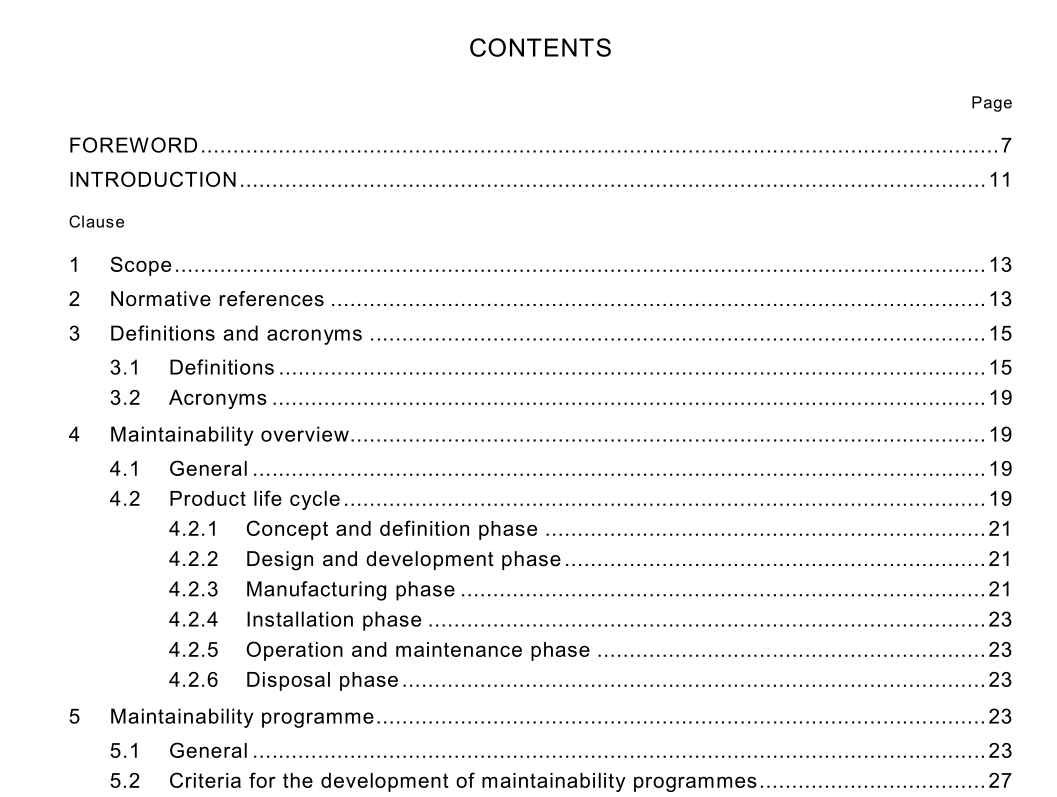IEC 60300-3-10 pdf download

IEC 60300-3-10 pdf download.Dependability management
1 Scope
This International Standard, which forms part of the series of standards in the IEC 60300-3 series, is the application guide for maintainability. It can be used to implement a maintainability programme covering the initiation, development and in-service phases of a product, which form part of the tasks described in IEC 60300-2. It provides guidance on how the maintenance aspects of the tasks should be considered in order to achieve optimum maintainability. It should be noted that the full programme described in this standard would only be applied to a major complex product with the potential for long- term usage. For less complex maintainable products, a simpler programme should be adopted by tailoring the programme to suit the degree of complexity and the requirements of the customer. The standard uses other IEC standards and guides, notably IEC 60706, as reference documents or tools to provide more detail as to how a task should be undertaken. Contracts between customer and supplier will vary widely according to conditions and circumstances in different industries. This standard is written on the premise that a product is to be developed by a contractor from a basic concept for the particular requirements of a user when the product is considered to be a development item (DI). However, in many instances, where a product already exists and needs little or no development effort; it is a Non- development item (NDI) and the full maintainability programme as described in this standard will not be required. However, the principles laid down in the standard can be applied as required, by tailoring the maintainability programme to suit the needs of the project.
3 Definitions and acronyms
For the purposes of this standard, the definitions given in IEC 60050(191) and the following apply. 3.1 Definitions 3.1.1 maintainability (performance) the ability of an item under given conditions of use, to be retained in, or restored to, a state in which it can perform a required function, when maintenance is performed under given conditions and using stated procedures and resources NOTE The term “maintainability” is also used as a measure of maintainability performance (see 191-13-01). [IEV 191-02-07] 3.1.2 maintainability the probability that a given active maintenance action, for an item under given conditions of use can be carried out within a stated time interval, when the maintenance is performed under stated conditions and using stated procedures and resources NOTE The term “maintainability” is also used to denote the maintainability performance quantified by this probability (see 191-02-07). [IEV 191-13-01] 3.1.3 maintenance the combination of all technical and administrative actions, including supervision actions, intended to retain an item in, or restore it to, a state in which it can perform a required function [IEV 191-07-01] 3.1.4 maintenance echelon (line of maintenance) a position in an organization where specified levels of maintenance are to be carried out on an item NOTE 1 Examples of maintenance echelons are: field, repair shop, manufacturer. NOTE 2 The maintenance echelon is characterized by the skill of the personnel, the facilities available, the location, etc. [IEV 191-07-04] 3.1.5 level of maintenance the set of maintenance actions to be carried out at a specified indenture level NOTE Examples of a maintenance action are replacing a component, a printed circuit board, a subsystem, etc. [IEV 191-07-06] 3.1.6 maintenance concept application of a general maintenance policy to a specific item 3.1.7 maintenance policy general interrelationship between levels of maintenance, lines of maintenance and maintenance conditions to be applied for the maintenance of an item 3.1.8 provisioning process of determining and acquiring the range and quantity (depth) of spares and repair parts, and support and test equipment required to operate and maintain a product for an initial period of service 3.1.9 supportability degree to which system design characteristics and planned logistic resources, including manpower, meet system operational utilization requirements









